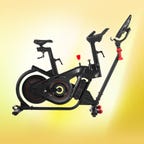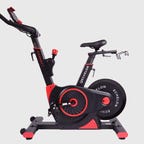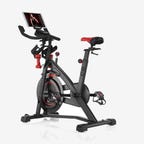
For some people, working out at home leads to a more comfortable and consistent experience. A home-based exercise bike is a fairly small piece of equipment that allows you to get a spin class-style workout without going to the gym. One of the major players in this space is Peloton, as it gives users a bike and on-demand classes.
However, these popular exercise bikes come with a hefty price tag. On top of that, you’ve got to pay the mandatory monthly Peloton subscription fee required to access classes. It’s a lot of money, especially if you want to start working out at home and aren’t fully sure about diving into the Peloton community.

Don’t miss our live, round-the-clock coverage of the Best Prime Day Deals curated by CNET Deals experts.
Whether you’re considering this as a gift to the exercise buff in your life or looking to get one for yourself, there are some exceptional Peloton alternatives out there. We’ve tested several stationary bike options to help you find the best Peloton bike alternative to fit your budget and fitness goals.
Which is the best Peloton alternative?
I’ve been testing indoor bikes for more than five years now, and while I don’t think there’s a single bike that’s perfect for all people I would say the best overall Peloton alternative is the BowFlex Velocore series. If you’re looking for a large display with a lot of options on the screen that Peloton is never going to offer, you’ll be happy with this bike. If having a giant screen doesn’t matter as much to you, there’s a budget-friendly version with a 16-inch display instead.
Editor’s note, June 10: BowFlex filed for Chapter 11 bankruptcy earlier this year and the brand is now owned by Johnson Health Tech, which also owns Horizon Fitness and Matrix. You can still buy BowFlex products through its website and via retailers such as Amazon and Dick’s Sporting Goods.
Best Peloton alternatives of 2024
Filter by
BowFlex is known for its home workout machines, but its Velocore series is genuinely something anyone can enjoy. The bike is surprisingly modular, and its magnetic resistance system allows you to get a whole-body workout without making a ton of noise. The big front wheels make it easy to move around and you can use the big speakers on the front of the display, although Bluetooth is also an option. The truly unique part of this design is the way it allows you to lean into your rides thanks to a locked hinge, which offers a core workout while you ride.
What makes this exercise bike stand out is everything you get on the screen. The BowFlex JRNY service does require a subscription to use, but at $20 per month, it’s less than half the cost of Peloton’s service and offers a ton of things you can’t get elsewhere. If you want a growing set of classes to give you a clear set of instructions for working out, BowFlex has quite a bit to offer through its subscription service. If that’s not your thing, there are loads of other options including just watching Netflix or Hulu or even Max while you ride. It’s something few other bikes do unless you bring your own screen, and BowFlex does it with ease.
A lot of indoor bike manufacturers try to compete with Peloton on price without sacrificing a ton in quality, but Echelon does it better than most. If you’re new to cycling without knowing whether this is something you want to massively invest in, a budget option that’s fun to use makes a big difference. The frame on the Echelon EX-3 is sturdy, offers a rear flywheel with magnetic resistance, and it’s got a great tablet and phone mount you can position however you want. It’s also got rear-mounted water bottle holders, which isn’t common with indoor bikes but nice if you want to feel like you’re simulating an outdoor ride on a performance bike.
Echelon’s bikes are not a 100% copy of the Peloton experience. If you’ve used a Peloton before, you’ll notice this bike is a little louder and the magnetic resistance is a little sudden and intense by comparison. What you do get is a Bluetooth connection so you can use just about any app to tell you how well your workout went, and at a price that even if you add in the optional subscription from Echelon is dramatically less than what you’ll find anywhere else.
Maybe you don’t want to stare at a screen while some spectacularly fit 22-year-old instructor yells at you to pick up the pace. Many bikes with screens offer a small amount of other distractions — like recordings of a bike on a trail somewhere exotic or a selection of streaming apps to watch a movie — but there’s something to be said for the flexibility of bringing your own screen. If you’re looking for a bike that’s well made and supports multiple body types without forcing you into a single experience for working out, the BowFlex C6 is what you want.
The device mount on the handlebars of the BowFlex C6 makes it easy to bring your own screen and mount it however you see fit, but the Bluetooth data sharing also makes it possible to set your bike in front of a TV and enjoy an even larger set of distractions. Most cycling apps will pair with the BowFlex C6 easily, but it’s worth pointing out that some performance-based apps like Zwift don’t always get the most accurate information from this bike.
Myx bikes have always been aimed at hardcore fitness fans, but when Myx merged with the folks at BeachBody, an already great experience expanded to way more people with the Myx II Plus. This is a great bike for a variety of body types, and it allows you to adjust your screen in just about every direction. Unlike many of its competitors, Myx II Plus makes it easy to share the bike with up to five other people without needing multiple subscriptions.
Where most exercise bikes offer the ability to do a variety of workouts while on the bike, Myx II Plus offers a ton of things to do off the bike as well. The included software offers everything from yoga to kettlebell classes with everything in between in addition to an array of spin class-style workouts and even live classes you can join throughout the week. It’s one of the few exercise bikes in this price range that can truly deliver a full-body workout.
The bike seems to have been renamed to BODi Bike now in a rebranding effort.
Note: This bike was recalled by the Consumer Product Safety Commission due to injury hazard in 2022.
Peloton’s cycle is, without question, the Bentley of home exercise bikes — a sturdy and beautiful machine that feels every inch like a premium product. It has a price tag to match the Peloton experience: $2,495, plus $44 a month for on-demand and live classes. If you’ve got the money, the Peloton Bike Plus really is a great bike.
Although I didn’t love having to buy (and use) special clip-in cycle shoes, I did enjoy the overall Peloton experience. The high-energy cycling classes are fun and engaging, with a huge variety of instructors, music genres and difficulty levels — something for everyone. Read our full Peloton Bike Plus review here.
One thing almost every bike with a screen on it has in common is the manufacturer makes the rules. You have a nice, large screen in front of you but can only access what they want you to see and experience if you pay for the access. Some offer additional apps you can install, but the list is extremely limited and typically only includes streaming TV shows or movies. Stryde makes it clear on its site the tablet on the front of its bike is a fully unlocked device running Android, so the only limit is your desire to tinker with your bike.
When you’re not trying to install Zwift or TrainerRoad on your tablet, the bike itself looks really nice and offers a comparable level of magnetic resistance to simulate any kind of cycling. You don’t have to pay for the subscription service if you don’t think the included classes are particularly valuable, but if you’re looking for a Peloton-like training regiment you’ll find a lot to like there.
Comparing Peloton alternatives
| Max weight (pounds) | Cost | Dimensions (LxWxH, inches) | Screen size (inches) | Workout types | |
|---|---|---|---|---|---|
| BowFlex VeloCore | 325 | $1,799 | 59.8″ L x 24.1″ W x 55.3″ H | 16″ or 22″ | Full body |
| Echelon EX3 | 300 | $755 | 59″ L x 23″ W x 53″ H | Tablet holder only | Cycling only |
| BowFlex C6 | 330 | $799 | 54.6″ L x 30.7″ W x 51.8″ H | Tablet holder, performance-only LCD | Cycling only |
| Myx II Plus/BODi Bike | 350 | $1,399 | 54″ L x 21″ W x 47″ H | 21.5″ | Full body |
| Peloton Bike Plus | 297 | $2,495 | 59″ L x 22″ W x 59″ H | 23.8″ | Full body |
| Stryde | 350 | $1,495 | 49.6″ L x 24″ W x 46″ H | 21.5″ | Cycling only |
Every indoor bike has the same basic feature set, but testing any bike as a viable Peloton alternative means the bike needs to meet a few basic benchmarks. When testing any indoor bike, we’re primarily interested in measuring the following:
- Size, stability and comfort: How well this bike fits in your home and how comfortable it is to ride in a home. This includes ease of assembly, how much noise the bike makes and how well it tucks away when not in use if that’s what you need in your space.
- Software features: If this is a Peloton alternative, it needs to be able to deliver a lot of different things all at once. This includes heart-rate monitoring and reporting, access to a wide variety of workout types and the ability to use your bike in a competitive workout environment (real or virtual)
- Cycling flexibility: It’s important that the indoor bikes we consider as Peloton alternatives be able to challenge a wide variety of skill levels. This means something on this list allows for clearly defined difficulty levels and allows for someone with preferred cycling shoes to comfortably use the bike.
Each bike we have access to is thoroughly tested by riding in three different situations: HIIT workouts, 20-mile performance rides and more casual 30-minute cycling sessions. If we have not yet had access to the bike but find its features interesting, this detail is called out in the section.
There’s no such thing as one bike for every kind of rider out there, and while Peloton makes a great bike there may be better options out there depending on your needs. With that in mind, we test all of our indoor bikes using the same criteria.
Price
Consider how much you’re willing to spend on an indoor bike. A big part of our testing is identifying which areas of an ideal cycling experience can be reduced to save money without impacting the quality of your workout.
Subscription quality
Many smart bikes now include a subscription to access their classes. Decide if a member subscription is important to your indoor cycling experience or if you want an option to just ride. For example, some subscription services offer less expensive options to add family members.
Physical space
A lot of indoor bikes take up a lot of room, and a big part of making sure your purchase doesn’t quickly become a very expensive clothesline is making sure it’s the right size for your space without sacrificing the things that make a good workout.
Workout quality
At the end of the day whatever bike you choose needs to be enjoyable to use. This means testing the seat for extended periods, as well as the different riding positions you’d want to be in while riding.
Like so many other things at CNET, we test exercise bikes as thoroughly as possible through rigorous examination and comparison. Each exercise bike in our list has been through at least 100 miles of riding, using as many of the built-in features as possible. Every exercise bike is judged against the following metrics:
Exercise bike volume
Every workout makes some noise, but a quieter bike typically means greater build quality. At the same time, if an exercise bike has a built-in display with speakers it’s important to know it’s possible to clearly hear the class instructor or your favorite TV show over the sound of you working out.
Riding position flexibility
It’s important to be able to set your exercise bike to the riding position that works best for you and be able to ride in that position for extended periods. All of the bikes in this list are tested in cruiser, neutral and competition riding positions to ensure comfort for as many body types as possible.
Software compatibility
Even if your bike doesn’t have a display, it likely has a way to connect to your phone or tablet to access performance apps. That testing doesn’t end at the ability to connect to a phone, the accuracy of the information sent from the bike to your phone makes a big difference, especially if you’re counting calories or you want to use a competitive racing app to ride with friends. Making sure the power you push into your exercise bike is accurately reflected in the information sent to apps makes a big difference.
Peloton is considered the best of the best when it comes to exercise bikes. Other exercise bikes allow you to do the same workouts with some differences. For example, there may be bikes that have their own version of a touchscreen and cycling classes. Most workouts you do on a Peloton can be done on a Peloton alternative as well. Some exercise you may want to try include:
- Low intensity ride: If you’re new to using an exercise bike, you would benefit from getting acquainted with it first. This can include riding it for a short period and getting used to the resistance levels, as well as making sure the seat is set up adequately for your height. Low intensity rides where you’re not trying to hit any PR’s can also provide cardiovascular benefits without getting significantly out of breath.
- High Intensity Interval Training (HIIT): If you’re used to riding on an exercise bike, then you’re familiar with HIIT rides. You use short bursts of energy followed by a rest period and you can play around with the resistance to make the ride harder or easier. Additionally, it’s a good way to get a quick workout in less than a half hour.
- Hills and Sprinting: If you’re focusing on improving your stamina and endurance, practicing cycling uphill with heavy resistance and sprinting on little to no resistance on an exercise bike is a good way to do so.
- Adjust saddle and handle bars accordingly: One of the first things you have to make sure is set up correctly on an exercise bike, is the seat (saddle) and handlebars height. This will vary per person, but ideally you want the seat to be hip height and you may need to make additional adjustments.
- Wear the right shoes: Some Peloton alternatives may require clip-in shoes (just like Peloton), while others have cages that are appropriate for any sneaker. Make sure your feet are properly strapped in or clipped in before riding.
- Know all the exercise bike features: It helps to know which way to turn the knob on your exercise bike to add or take away resistance. If there is a touchscreen, it’s helpful to know how to access the classes and other features on your device. Additionally, for safety reasons it’s important to know how to abruptly stop the bike in case of an emergency.
Which bike is Peloton’s biggest competitor?
What should I look for when buying an indoor exercise bike?
Which muscles does indoor cycling work?
Is a built-in or BYO screen better?
Is a subscription necessary?


